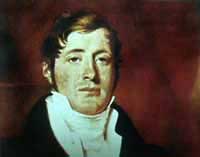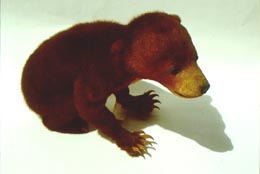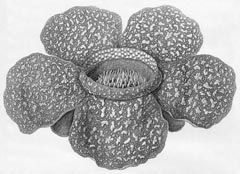|
|
|

Thomas Stamford Raffles was born at sea on board a ship Ann on the 6th of July, 1781 off the coast of Jamaica. In 1795, the young man accepted his first job in the East India Company as a clerk. But he studied hard in his spare time and in 1804, was posted to Penang (then Prince of Wales Island) and promoted to Assistant Secretary to the Presidency of that Malaysian island. His mastery over the Malay language made him indispensable to the British Government, and he was later appointed Malay translator to the Government of India. In 1811, he returned as the Lieutenant Governor of Java, and was soon promoted to Governor of Bencoolen (now Sumatra). On 19th January, 1819, Raffles founded modern Singapore and first mooted the idea which led to the establishment of the Raffles Museum on the island.
Stamford Raffles was deeply fascinated by the immense diversity of strange animals and plants of the East Indies during his tenure there. He soon employed zoologists and botanists to discover all they can about the animals and plants of the region and would pay his assistants out of his own pockets to collect specimens. He also revived and became the president of the Batavian Society which was actively engaged in the study of natural history of Java and adjacent areas
 |
In her memoirs of him, his wife Lady Sophia Raffles, also mentions his zoological collection, among which were beautiful specimens of tapirs, rhinoceros and barking deer. She mentions that these were sent to England. Raffles also kept some animals as pets. A Sun Bear cub he reared with his children reportedly often joined him for dinner, eating mangoes and drinking champagne. |
| Malayan Sun Bear |
Raffles' principal assistant Abdullah, also his Malay tutor, was engaged in packing all the stuffed skins and skeletons which numbered some one-thousand specimens. Earlier, throughout his time in Java and Sumatra, Raffles had sent home many consignments of creatures preserved in spirit. Lady Raffles recalls that Raffles' interest in biology was great as evidenced by references to plants and animals in most of his letters. He had compiled a long list of animals of which, he believed nothing is yet known beyond the name and native descriptions.
On his return journey to England in 1824 on the ship Fame, he lost a huge consignment of plant and animal specimens, notes, papers and even certain drawings to a fire aboard. Upon his return, he founded the now world famous Zoological Society of London of which he was its first president, and the London Zoo.
Sir Thomas Stamford Raffles passed away a day before his 45th birthday in 1826. A few years earlier, in 1821 and 1822, he contributed two papers in the Transactions of the Zoological Society, London, with descriptions of some 34 species of birds and 13 species of mammals, chiefly from Sumatra. Most of the new species he named are valid today, and these animals will continue to remind us of the contributions he has made. Animals named by Raffles himself include:
MAMMALS:
Echinosorex gymnurus Moonrat
Tupaia tana Large Treeshrew
Macaca fascicularis Crab-eating Macaque
Presbytis melalophos Mitred Leaf Monkey
Semnopithecus cristatus Silvered Leaf Monkey
Hylobates syndactylus Siamang
Ursus malayanus Sun Bear
Arctictis binturong Binturong or Bear-cat
Ratufa affinis Cream-coloured Giant Squirrel
Rhizomys sumatrensis Large Bamboo Rat
 |
 |
| Cream-coloured Giant Squirrel | Milky Stork from West Java |
BIRDS:
Ardea sumatrana Great-billed Heron
Gorsachius melanolophus Malayan Night Heron
Mycteria cinerea Milky Stork
Lophura erythrophthalma Crestless Fireback Pheasant
Rallina fasciata Red-legged Crake
Sterna sumatrana Black-naped Tern
Ducula badia Mountain Imperial Pigeon
Phaenicophaeus sumatranus Chestnut-bellied Malkoha
Phaenicophaeus chlorophaeus Raffles' Malkoha
Bubo sumatranus Barred Eagle Owl
Ninox scutulata Brown Hawk Owl
Harpactes kasumba Red-naped Trogon
Berenicornis comatus White-crowned Hornbill
Anthracoceros malayanus Black Hornbill
Corydon sumatranus Dusky Broadbill
Eurylaimus ochromalus Black-&-Yellow Broadbill
Calyptomena viridis Green Broadbill
Pitta caerulea Giant Pitta
Tephrodornis gularis Large Wood Shrike
Pericrocotus divaricatus Ashy Minivet
Muscicapa latirostris Brown Flycatcher
Cyornis rufigastra Mangrove Blue Flycatcher
Aethopyga siparaja Crimson Sunbird
As Stamford Raffles was well-known in natural history circles, a number of animals and plants have been named in his honour. They include Megalaima rafflesi (Red-crowned Barbet), Dinopium rafflesii (Olive-backed Woodpecker) and Chaetodon rafflesi (Latticed Butterflyfish). Perhaps the most distinctive organism named after him would be Rafflesia, a genus of plants parasitic on palm trees which he discovered on an expedition to a jungle in Sumatra. These are endemic to Southeast Asia and produce the world's largest and possibly the most spectacular (abeit evil-smelling) flowers.

Rafflesia arnoldi

For more information on Singapore History, Please visit the following sites:

[Hit Counter]
